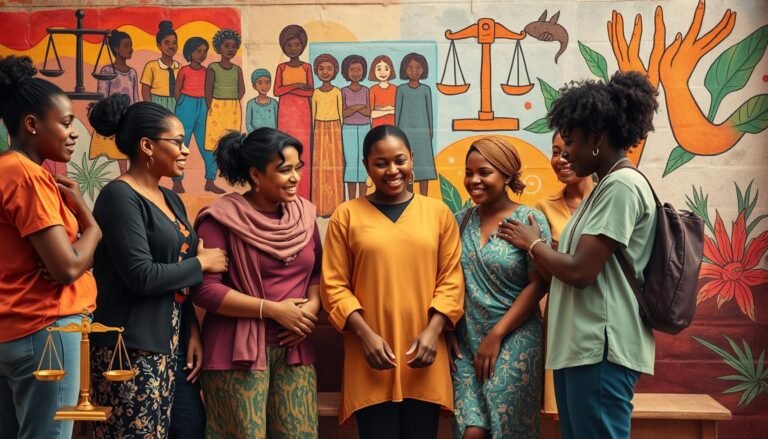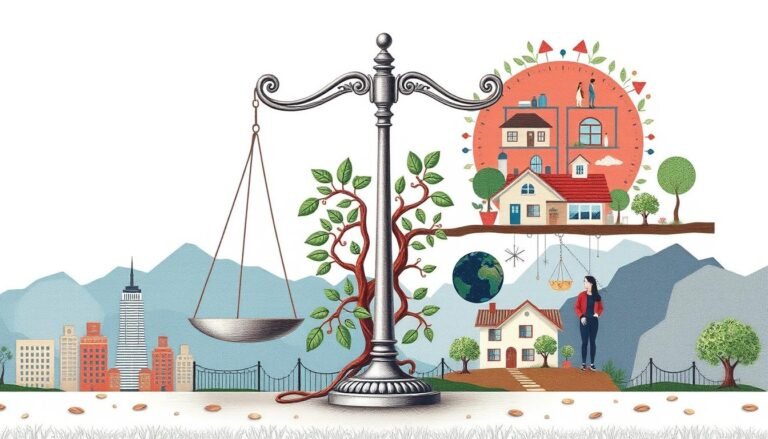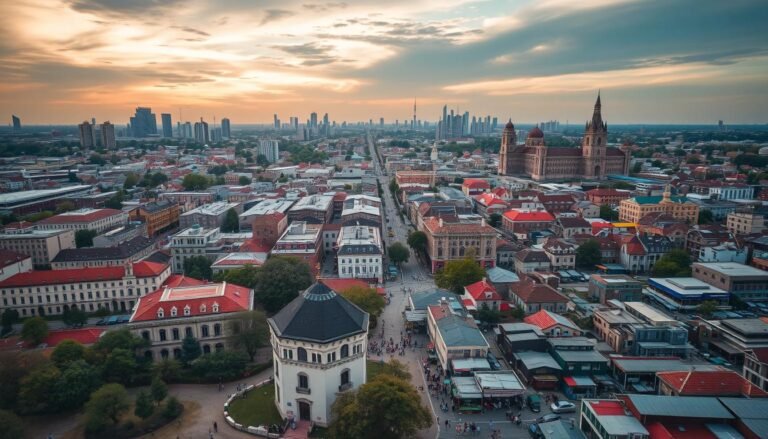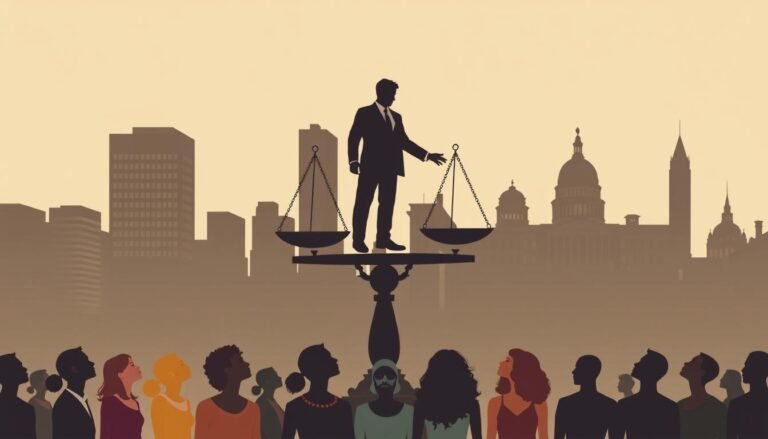Social Networks and Their Influence on Behavior
Have you ever thought about how your online life shapes who you are? Today, social networks are a big part of our lives. They deeply affect our behavior in ways we might not see.
Platforms like Facebook, Instagram, and Twitter have billions of users around the world. These online groups shape our thoughts and actions every day. They influence what we see and how we show ourselves online.
Most people use social media many times a day. This can have good and bad effects on our mental health, relationships, and how we see ourselves. For instance, too much social media can make us feel sad or worried about our looks.
Social networks also change how we act as consumers and how we keep and make friends. They can make us feel jealous or insecure.
Looking into social networks and their effects on us is important. We need to know the good and bad sides. This way, we can use these digital spaces wisely and make a positive change.
Key Takeaways
- Social networks greatly affect our daily actions and choices
- Billions of people use social media often
- Using social media too much can hurt our mental health and self-esteem
- Our online interactions change how we buy things and our relationships
- It’s key to understand social networks to have a good online experience
The Evolution of Social Networks in the Digital Age
Social networks have changed a lot in the digital age. They started as simple online communities and have grown into complex social media platforms. These changes have changed how we connect and share information.
From Early Online Communities to Modern Social Platforms
The journey started with chat rooms and forums. Now, we have big platforms like Facebook and YouTube. These platforms are huge, with billions of users around the world. Some countries have blocked these platforms, affecting about 1.6 billion people.
The Rise of Mobile Social Networking
Mobile technology changed social networking. Smartphones let us stay connected all the time. This change made social media a big part of our daily lives. Even older adults are using it, with 64% of those 50-64 years old on social media.
Key Players in the Social Media Landscape
As of March 2024, there are 101 social media platforms. This gives users many choices. Facebook and YouTube are the most popular. These platforms shape how we interact online with features like likes, shares, and comments.
Social networks have deeply changed how we communicate and interact. They’ve changed how we get news, form opinions, and see ourselves. Understanding this evolution is key for both users and developers.
Understanding the Psychology Behind Social Media Usage
Social media psychology is key to understanding how people act and interact online. It has changed how we connect and talk to each other.
A 2018 study by the Pew Research Center found that 88% of people aged 18-29 use social media. Even 64% of those 50 to 64 years old are regular users. This shows social media reaches a wide range of people.
Being active on social media affects our brain’s reward system. When we get likes on sites like Facebook, certain parts of the brain light up. These areas are linked to feeling rewarded. This can make us want to use social media more, leading to addictive behaviors.
“Social media can trigger the brain’s reward system, with likes on platforms like Facebook activating brain regions implicated in reward, such as the striatum and ventral tegmental area.”
People use social media for many reasons:
- Need for social acceptance
- Self-esteem enhancement
- Fear of missing out (FOMO)
- Self-expression and identity reproduction
- Information acquisition
These reasons lead people to create idealized online versions of themselves. This can make them feel anxious or not good enough when they compare themselves to others.
| Platform | Active Users | Key User Behavior |
|---|---|---|
| 1.71 billion monthly | 75% use daily | |
| Snapchat | 78% of young adults (18-24) | Frequent photo sharing |
| 500 million worldwide | 500 million tweets daily |
Knowing these psychological factors is important for dealing with social media’s effects on our lives and mental health.
Social Networks and Their Influence on Behavior
Social networks have a big impact on what we do and decide. They shape our health choices and how we act in many areas of life.
The Impact of Peer Influence in Online Communities
Friends in online groups can change our ways. Research shows that health habits like smoking and obesity spread in social circles. When we see our friends doing something, we’re more likely to do it too.
This effect isn’t just for health. It also applies to caring for the environment. Being around others who act green can make us want to do the same.
How Social Media Shapes Behavioral Patterns
Social media changes how we behave. With billions of users on Facebook, it’s a big place for sharing new behaviors. Studies show that how we’re connected online affects what we do.
This also affects our mental health. Being on social media too much can make us feel sad and less about ourselves. We might feel bad when we compare ourselves to others online.
The Role of Social Proof in Digital Interactions
Seeing others do something makes us more likely to do it too. This is called social proof. It helps spread good habits, like saving the environment.
Many people help push these good actions forward. The more we see others doing something, the more we want to do it too. This helps make big changes happen online.
“Social interactions and networks play a crucial role in accelerating the spread of pro-environmental behaviors and overcoming barriers to adoption of sustainable practices.”
Knowing how social networks work can help us use them for good. We can use them to make healthier choices and protect the planet.
The Power of Social Networks in Information Dissemination
Social networks have changed how we share information today. With over 3.8 billion users, they are key for news, shaping opinions, and spreading viral content.
Viral Content and Its Behavioral Consequences
Viral content on social media can change how people act. Facebook saw a 21% jump in monthly users to 1.15 billion, with daily users up 27% to 699 million. This big user base means content can spread fast.
Social Media as a News Source: Implications for Public Opinion
Many now get their news from social media, which shapes opinions. In crises, people share info before official news. This change affects how opinions are formed and spread.
The Spread of Misinformation and Its Effects on User Behavior
Social networks help share info fast but also spread false information. Without rules and anonymity, they can spread rumors and fake news, especially in health crises.
| Social Media Impact | Statistics |
|---|---|
| Global internet users | Over 4.5 billion |
| Social media users | Over 3.8 billion |
| Facebook monthly users increase | 21% year-over-year |
| Facebook daily users increase | 27% to 699 million |
Social networks have a big role in sharing information. As they grow, it’s key to understand their effects on viral content, opinions, and misinformation. This helps us navigate the digital world better.
Social Media’s Impact on Mental Health and Well-being
Social media has changed how we live online. People now spend about 2.3 hours daily on these platforms. It’s important to know how they affect our mental health. Studies show worrying trends in how we use the internet and their effects.
Studies link heavy social media use to more depression, anxiety, and loneliness. The World Health Organization says mental health issues are rising by 13% each year. Around the world, 264 million people struggle with anxiety, and 280 million with depression.
“Social media use can lead to body image dissatisfaction and decreased well-being.”
In Saudi Arabia, where 82.3% use social media, mental health problems hit about 20.2% of people. Depression affects 21%, anxiety 17.5%, and stress 12.6% of the population. There’s a clear link between social media and these mental health issues.
Fear of missing out (FOMO) makes people use social media too much, causing anxiety and low self-esteem. About 10% of teens get bullied online, which hurts their mental health. But, using social media in balance can help, making people feel less alone and more supported.
- Likes, comments, and followers contribute most to poor mental health
- Entertainment features have the highest impact on mental health
- Privacy settings have the least significant effect
To stay mentally healthy online, we need to use social media wisely. Learning how to use social media safely can lead to better online experiences. This helps reduce the bad effects on our mental health.
The Role of Social Networks in Shaping Identity and Self-Presentation
Social networks are key in shaping our identity and how we show ourselves to others. In our digital world, creating digital personas is common. These personas often show a perfect version of ourselves.
Digital Personas and Their Real-World Implications
Creating digital personas is a big thing on social platforms. People pick their online pictures and posts to look their best. This way of showing ourselves can change how people see us, both online and in real life.
The Influence of Social Comparison on Self-Esteem
Comparing ourselves to others is natural, but social media makes it worse. People often look at their friends’ lives and achievements online. This can make people feel bad about themselves, especially teens who use social media a lot.
“Adolescents participate actively in shaping their identity through social media interactions and self-presentation.”
Managing Online Reputation in the Age of Social Media
Now, managing our online image is key for our personal and work lives. What we post online can affect our future chances and relationships. So, we need to think about what we share online.
- Common types of self-presentation on social media include ingratiation and self-promotion
- Social media offers opportunities for adolescents to curate and present their identity to a broader audience
- Audience feedback on self-presentation contributes to shaping self-concept and identity
Social networks are changing, and so is their effect on how we see ourselves and present ourselves. It’s important to understand these changes to handle our online lives well and keep a good relationship with social media.
Social Networks and Consumer Behavior
Social networks have changed how we make choices when buying things online. They use social media marketing to influence us. This happens through recommendations from friends, content from users, and ads that target us.
Studies show that what others think matters a lot on these platforms. Seeing lots of likes, shares, and comments makes a product seem more popular and trustworthy. This can really affect what we decide to buy, as we often trust reviews from others.
Feeling left out, or FOMO, also plays a big part in our choices. It makes us want to buy things quickly. Reviews from real people make a strong connection with us, making us more likely to buy.
| Factor | Impact on Consumer Behavior |
|---|---|
| Social Proof | Influences credibility and popularity of products |
| User-Generated Content | Serves as authentic endorsement |
| FOMO | Drives impulsive purchasing decisions |
| Peer Recommendations | Highly influential in decision-making process |
Brands use social media well by using hashtags to get noticed and being open with their customers. Answering quickly to questions shows they care about us, which makes us more loyal.
Social networks are key in helping us decide what to buy. They help us find and judge products. Their trustworthiness, usefulness, and ease of use greatly affect our choices. This makes them a vital part of marketing today.
The Dark Side of Social Media: Cyberbullying and Online Harassment
Social media has become a place where cyberbullying and online harassment thrive. These issues affect many, especially young people. A 2022 Pew Research Center study showed that 46% of teens have faced cyberbullying on social media or their phones.
Understanding the Dynamics of Online Aggression
Cyberbullying comes in many forms across various platforms. The Cyberbullying Research Center found that 73% of teens who were bullied were targeted on popular social media sites. About half of these bullied teens were harassed through texts and messaging apps. Online gaming, forums, and chat rooms are also places where bullying happens.
The Psychological Impact of Cyberbullying on Victims
Cyberbullying deeply affects its victims. They often feel sad, angry, scared, and embarrassed. A study in Europe found that 38% of teens felt distressed from online harassment. Those who are bullied are more likely to have mental health issues like depression, anxiety, and thoughts of suicide.
Strategies for Combating Negative Online Behaviors
We need a strong plan to fight cyberbullying. This plan should involve parents, teachers, schools, and police. Teaching online safety, having strict anti-bullying rules on social media, and helping victims are key steps. Together, we can make the internet safer and lessen online harassment.
- Educate users about responsible online behavior
- Implement and enforce strong anti-bullying policies on social platforms
- Provide support systems and resources for cyberbullying victims
- Encourage bystanders to report and stand up against online harassment
Leveraging Social Networks for Positive Behavioral Change
Social media platforms are now key tools for promoting positive behavior change. They offer great chances for health promotion, education, and raising awareness. Studies show how effective social media can be in health areas.
A 6-month study on Mobile Pounds Off Digitally showed good results in weight loss. Facebook-based programs helped increase physical activity in young adult cancer survivors. These efforts show how social networks can help people live healthier.
Social media is also changing the game in sexual health education. A study found that social platforms work well for sharing important sexual health info. Online networks are also key in teaching about HIV prevention and education.
But it’s not just about health. Sites like Cancer.com and PatientsLikeMe connect people with important health info and support. This shows how social media can be a powerful tool for public health and doing good online. It opens up new ways to make positive changes in our lives.
Source Links
- Social Network Assessments and Interventions for Health Behavior Change: A Critical Review
- Exploring the Influence of Social Media on Human Behavior
- Social Media Impact: How Social Media Sites Affect Society
- The impact of the digital revolution on human brain and behavior: where do we stand?
- The Psychology of Social Media | King University Online
- Social media psychology and mental health – Middle East Current Psychiatry
- Online Social Networking and Mental Health
- Understanding students’ behavior in online social networks: a systematic literature review – International Journal of Educational Technology in Higher Education
- Multiple social network influences can generate unexpected environmental outcomes – Scientific Reports
- Social Media Role and Its Impact on Public Health: A Narrative Review
- Use of social network analysis in the development, dissemination, implementation, and sustainability of health behavior interventions for adults: A systematic review
- Influence of information attributes on information dissemination in public health emergencies – Humanities and Social Sciences Communications
- The Relationship between Social Media and the Increase in Mental Health Problems
- Pros & cons: impacts of social media on mental health – BMC Psychology
- Social Media and Mental Health: Social Media Addiction
- Focus on Self-Presentation on Social Media across Sociodemographic Variables, Lifestyles, and Personalities: A Cross-Sectional Study
- Social media: a digital social mirror for identity development during adolescence – Current Psychology
- How Social Media Impacts Consumer Behavior | Sprinklr
- Consumer Behavior under Social Network Platform Influencing Factors and Marketing Strategies
- Current perspectives: the impact of cyberbullying on adolescent health
- The Dark Side of Social Media: Cyberbullying
- Effects of Cyberbullying | Social Media Victims Law Center
- The influence of social networking sites on health behavior change: a systematic review and meta-analysis
- Social networks as influencers of health behavior change
- Neuropsychiatry: Leveraging Social Networks for the Assessment and Management of Neurological Patients







